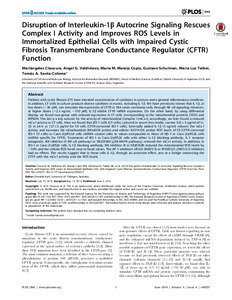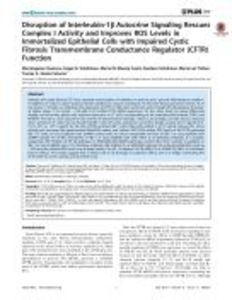Por favor, use este identificador para citar o enlazar este ítem:
https://repositorio.uca.edu.ar/handle/123456789/8675| Título: | Disruption of interleukin-1 β autocrine signaling rescues complex I activity and improves ROS levels in immortalized epithelial cells with impaired cystic fibrosis transmembrane conductance regulator (CFTR) function | Autor: | Clauzure, Mariángeles Valdivieso, Ángel Gabriel Massip Copiz, María Macarena Schulman, Gustavo Teiber, María Luz Santa Coloma, Tomás Antonio |
Palabras clave: | MEDICINA; PROTEINAS; CELULAS EPITELIALES; FIBROSIS QUISTICA; CFTR; GENES | Fecha de publicación: | 2014 | Editorial: | Dominik Hartl, University of Tübingen, Germany | Cita: | Clauzure M, Valdivieso AG, Massip Copiz MM, Schulman G, Teiber ML, et al. (2014) Disruption of Interleukin-1b Autocrine Signaling Rescues Complex I Activity and Improves ROS Levels in Immortalized Epithelial Cells with Impaired Cystic Fibrosis Transmembrane Conductance Regulator (CFTR) Function. PLoS ONE 9(6): e99257. doi:10.1371/journal.pone.0099257. Disponible en: https://repositorio.uca.edu.ar/handle/123456789/8675 | Resumen: | Abstract: Patients with cystic fibrosis (CF) have elevated concentration of cytokines in sputum and a general inflammatory condition. In addition, CF cells in culture produce diverse cytokines in excess, including IL-1b. We have previously shown that IL-1b, at low doses (,30 pM), can stimulate the expression of CFTR in T84 colon carcinoma cells, through NF-kB signaling. However, at higher doses (.2.5 ng/ml, ,150 pM), IL-1b inhibit CFTR mRNA expression. On the other hand, by using differential display, we found two genes with reduced expression in CF cells, corresponding to the mitochondrial proteins CISD1 and MTND4. The last is a key subunit for the activity of mitochondrial Complex I (mCx-I); accordingly, we later found a reduced mCx-I activity in CF cells. Here we found that IB3-1 cells (CF cells), cultured in serum-free media, secrete 32365 pg/ml of IL- 1b in 24 h vs 12763 pg/ml for S9 cells (CFTR-corrected IB3-1 cells). Externally added IL-1b (5 ng/ml) reduces the mCx-I activity and increases the mitochondrial (MitoSOX probe) and cellular (DCFH-DA probe) ROS levels of S9 (CFTR-corrected IB3-1 CF cells) or Caco-2/pRSctrl cells (shRNA control cells) to values comparable to those of IB3-1 or Caco-2/pRS26 cells (shRNA specific for CFTR). Treatments of IB3-1 or Caco-2/pRS26 cells with either IL-1b blocking antibody, IL-1 receptor antagonist, IKK inhibitor III (NF-kB pathway) or SB203580 (p38 MAPK pathway), restored the mCx-I activity. In addition, in IB3-1 or Caco-2/pRS26 cells, IL-1b blocking antibody, IKK inhibitor III or SB203580 reduced the mitochondrial ROS levels by ,50% and the cellular ROS levels near to basal values. The AP-1 inhibitors U0126 (MEK1/2) or SP600125 (JNK1/2/3 inhibitor) had no effects. The results suggest that in these cells IL-1b, through an autocrine effect, acts as a bridge connecting the CFTR with the mCx-I activity and the ROS levels. | URI: | https://repositorio.uca.edu.ar/handle/123456789/8675 | ISSN: | 1932-6203 (electrónico) | Disciplina: | MEDICINA | DOI: | 10.1371/journal.pone.0099257 | Derechos: | Acceso abierto | Fuente: | PLoS ONE Vol. 9, N° 6, 2014 |
| Aparece en las colecciones: | Artículos |
Ficheros en este ítem:
| Fichero | Descripción | Tamaño | Formato | |
|---|---|---|---|---|
| disruption-interleukin-autocrine-signaling.pdf | 1,67 MB | Adobe PDF |  Visualizar/Abrir | |
| disruption-interleukin-autocrine-signaling.jpg | 6,64 kB | JPEG |  Visualizar/Abrir |
Visualizaciones de página(s)
148
comprobado en 30-abr-2024
Descarga(s)
136
comprobado en 30-abr-2024
Google ScholarTM
Ver en Google Scholar
Altmetric
Altmetric
Este ítem está sujeto a una Licencia Creative Commons

